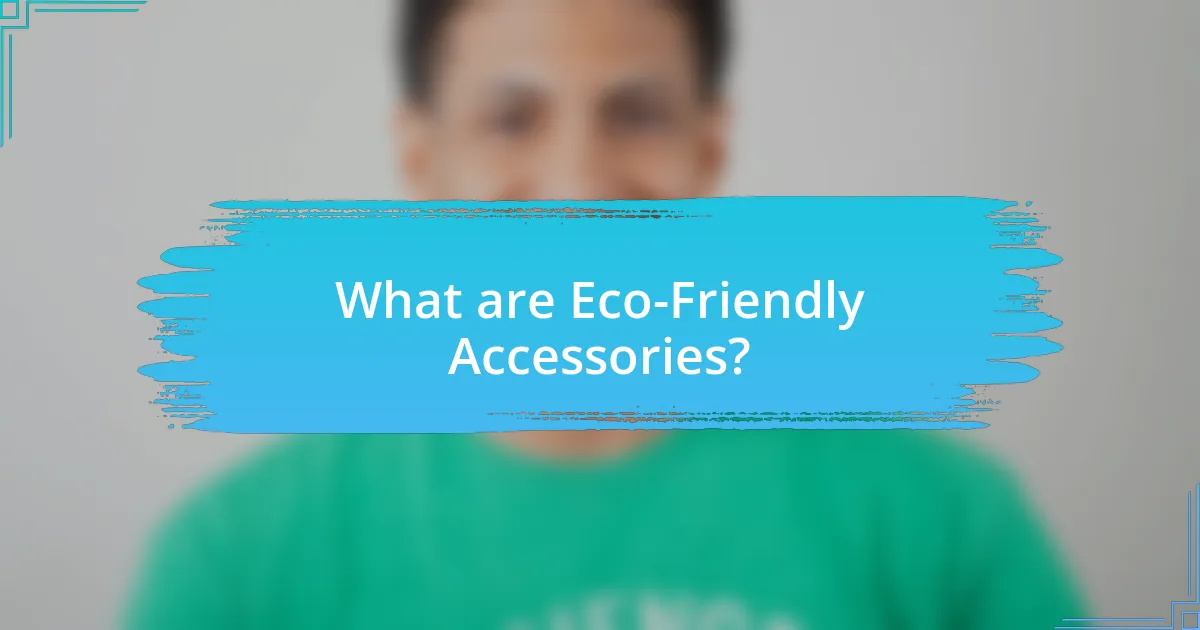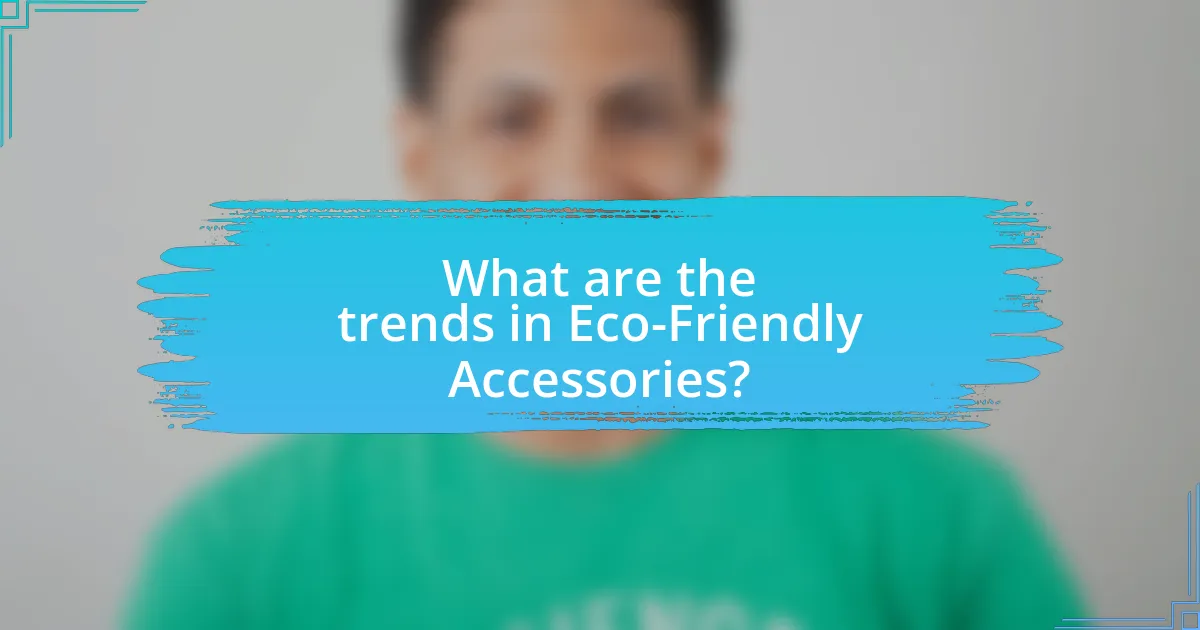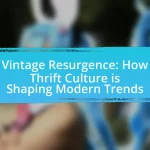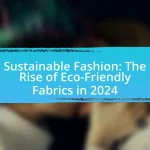Eco-friendly accessories are products designed to minimize environmental impact through sustainable materials and ethical manufacturing processes. This article explores the differences between eco-friendly and traditional accessories, highlighting materials commonly used, such as organic cotton and recycled plastics, and the importance of sustainable production methods. It also discusses the significance of eco-friendly accessories for conscious consumers, their environmental benefits, and how they contribute to ethical consumerism. Additionally, the article examines trends in the market, challenges faced by eco-friendly brands, and practical tips for consumers to identify and choose sustainable options.

What are Eco-Friendly Accessories?
Eco-friendly accessories are products designed to minimize environmental impact, often made from sustainable materials or through ethical manufacturing processes. These accessories include items like bags, jewelry, and clothing that utilize organic fabrics, recycled materials, or biodegradable components. For instance, a study by the Ellen MacArthur Foundation highlights that the fashion industry contributes significantly to pollution, making the shift to eco-friendly alternatives crucial for sustainability.
How do Eco-Friendly Accessories differ from traditional accessories?
Eco-friendly accessories differ from traditional accessories primarily in their materials and production processes, which prioritize sustainability and environmental impact. Eco-friendly accessories are typically made from renewable, biodegradable, or recycled materials, such as organic cotton, bamboo, or recycled plastics, whereas traditional accessories often utilize non-renewable resources and synthetic materials that contribute to pollution and waste. For example, a study by the Ellen MacArthur Foundation highlights that the fashion industry is responsible for 92 million tons of waste annually, much of which comes from conventional accessory production. This stark contrast underscores the commitment of eco-friendly accessories to reduce environmental harm and promote sustainable practices.
What materials are commonly used in Eco-Friendly Accessories?
Eco-friendly accessories are commonly made from sustainable materials such as organic cotton, bamboo, recycled plastics, cork, and hemp. Organic cotton is cultivated without harmful pesticides, making it a safer choice for the environment. Bamboo grows rapidly and requires minimal resources, while recycled plastics help reduce waste by repurposing materials that would otherwise contribute to pollution. Cork, harvested from the bark of cork oak trees, is renewable and biodegradable. Hemp is a durable fiber that requires little water and no pesticides, making it an environmentally friendly option. These materials collectively contribute to reducing the ecological footprint of fashion accessories.
How do production processes impact the sustainability of these accessories?
Production processes significantly impact the sustainability of eco-friendly accessories by determining resource efficiency, waste generation, and environmental footprint. Sustainable production methods, such as using renewable materials and minimizing energy consumption, reduce the ecological impact of accessory manufacturing. For instance, the use of organic cotton instead of conventional cotton can decrease water usage by up to 91% and eliminate harmful pesticide use, thereby promoting a healthier ecosystem. Additionally, processes that prioritize recycling and upcycling materials contribute to lower waste levels, as seen in brands that utilize post-consumer plastics to create new products. These practices not only enhance the sustainability of accessories but also align with consumer demand for environmentally responsible choices.
Why are Eco-Friendly Accessories important for the conscious consumer?
Eco-friendly accessories are important for the conscious consumer because they align purchasing decisions with environmental sustainability. These accessories are typically made from sustainable materials, reducing waste and pollution, which is crucial as the fashion industry contributes significantly to global carbon emissions. For instance, a report by the Ellen MacArthur Foundation states that the fashion industry is responsible for 10% of global carbon emissions, highlighting the need for more sustainable practices. By choosing eco-friendly accessories, consumers actively support ethical production methods and contribute to a circular economy, promoting a healthier planet.
What environmental benefits do Eco-Friendly Accessories provide?
Eco-friendly accessories reduce environmental impact by minimizing waste and promoting sustainable materials. These accessories often utilize biodegradable, recycled, or organic materials, which decrease reliance on non-renewable resources and lower carbon emissions during production. For instance, using recycled plastics in accessories can divert waste from landfills and reduce ocean pollution, as highlighted by the Ocean Conservancy’s report on plastic waste. Additionally, eco-friendly accessories often support ethical manufacturing practices, which can lead to improved labor conditions and reduced environmental degradation in production regions.
How do these accessories contribute to ethical consumerism?
Eco-friendly accessories contribute to ethical consumerism by promoting sustainable practices and reducing environmental impact. These accessories are often made from recycled, organic, or sustainably sourced materials, which minimizes resource depletion and pollution. For instance, a study by the Ellen MacArthur Foundation highlights that using recycled materials can significantly lower carbon emissions compared to virgin materials. Additionally, many eco-friendly accessory brands prioritize fair labor practices, ensuring that workers are paid fairly and work in safe conditions, which aligns with ethical consumer values. This combination of sustainable sourcing and ethical labor practices empowers consumers to make choices that support both environmental sustainability and social responsibility.

What styles of Eco-Friendly Accessories are available?
Eco-friendly accessories are available in various styles, including sustainable jewelry, biodegradable bags, recycled fabric clothing, and natural material footwear. Sustainable jewelry often features materials like recycled metals and ethically sourced stones, while biodegradable bags are made from materials such as jute or organic cotton. Recycled fabric clothing utilizes post-consumer waste, and natural material footwear is crafted from materials like hemp or cork. These styles not only promote environmental sustainability but also cater to diverse consumer preferences, reflecting a growing trend towards eco-conscious fashion.
What types of Eco-Friendly Accessories can consumers choose from?
Consumers can choose from a variety of eco-friendly accessories, including biodegradable phone cases, recycled material bags, sustainable jewelry, and organic cotton scarves. Biodegradable phone cases are made from materials that decompose naturally, reducing plastic waste. Recycled material bags, often crafted from repurposed plastics or fabrics, help minimize landfill contributions. Sustainable jewelry, made from ethically sourced materials, supports fair trade practices. Organic cotton scarves are produced without harmful pesticides, promoting environmental health. These options reflect a growing trend towards sustainability in consumer choices.
How do Eco-Friendly bags compare to conventional bags?
Eco-friendly bags are generally more sustainable than conventional bags, as they are made from biodegradable or recycled materials, reducing environmental impact. Conventional bags, often made from plastic, contribute significantly to pollution and take hundreds of years to decompose. For instance, studies indicate that single-use plastic bags account for a substantial portion of marine debris, harming wildlife and ecosystems. In contrast, eco-friendly bags can be reused multiple times, further minimizing waste. According to the Environmental Protection Agency, using reusable bags can reduce the demand for single-use plastics, thereby decreasing landfill contributions and promoting a healthier planet.
What are the options for Eco-Friendly jewelry?
Eco-friendly jewelry options include pieces made from recycled materials, ethically sourced gemstones, and sustainable metals like recycled gold or silver. Recycled materials reduce waste and environmental impact, while ethically sourced gemstones ensure that mining practices do not harm communities or ecosystems. Sustainable metals, such as those certified by organizations like the Responsible Jewelry Council, guarantee responsible sourcing and production practices. These options cater to consumers seeking stylish yet environmentally conscious choices in their jewelry.
How can consumers identify truly Eco-Friendly Accessories?
Consumers can identify truly eco-friendly accessories by looking for certifications such as Global Organic Textile Standard (GOTS) or Fair Trade, which ensure sustainable practices. Additionally, examining the materials used is crucial; accessories made from recycled, biodegradable, or organic materials typically indicate eco-friendliness. Transparency in sourcing and production processes also signals authenticity; brands that openly share their supply chain details are more likely to be genuinely committed to sustainability. Research shows that products with verified eco-labels reduce environmental impact, making these indicators reliable for consumers seeking eco-friendly options.
What certifications should consumers look for in Eco-Friendly products?
Consumers should look for certifications such as USDA Organic, Energy Star, Fair Trade, and Forest Stewardship Council (FSC) when selecting eco-friendly products. USDA Organic certification ensures that products are made without synthetic fertilizers or pesticides, promoting sustainable farming practices. Energy Star indicates energy efficiency, helping to reduce greenhouse gas emissions. Fair Trade certification guarantees that producers receive fair wages and work under safe conditions, supporting ethical sourcing. FSC certification ensures that wood and paper products come from responsibly managed forests, promoting environmental sustainability. These certifications provide consumers with assurance that the products they choose align with eco-friendly and ethical standards.
How can consumers research brands for sustainability practices?
Consumers can research brands for sustainability practices by examining their official websites, sustainability reports, and third-party certifications. Many brands publish detailed information about their environmental policies, sourcing practices, and social responsibility initiatives on their websites. Additionally, sustainability reports often provide insights into a company’s performance and goals regarding sustainability. Third-party certifications, such as Fair Trade, USDA Organic, or B Corp, serve as credible indicators of a brand’s commitment to sustainable practices. According to a 2021 survey by Nielsen, 73% of global consumers are willing to change their consumption habits to reduce environmental impact, highlighting the importance of informed choices in supporting sustainable brands.

What are the trends in Eco-Friendly Accessories?
Trends in eco-friendly accessories include the increasing use of sustainable materials, such as recycled plastics, organic cotton, and biodegradable materials. Consumers are gravitating towards brands that prioritize ethical production practices and transparency in their supply chains. For instance, a report by Grand View Research indicates that the global market for eco-friendly accessories is expected to grow significantly, driven by rising consumer awareness about environmental issues and a preference for sustainable products. Additionally, personalization and customization options are becoming popular, allowing consumers to express their individuality while supporting eco-conscious brands.
How is the market for Eco-Friendly Accessories evolving?
The market for Eco-Friendly Accessories is rapidly expanding due to increasing consumer awareness and demand for sustainable products. According to a report by Grand View Research, the global eco-friendly products market is projected to reach $150 billion by 2025, with accessories being a significant segment driven by millennials and Gen Z consumers who prioritize sustainability. This shift is evidenced by brands adopting sustainable materials and practices, such as using recycled plastics and organic fabrics, to meet the growing preference for environmentally responsible choices.
What innovations are being introduced in Eco-Friendly accessory design?
Innovations in eco-friendly accessory design include the use of biodegradable materials, such as plant-based plastics and organic textiles, which reduce environmental impact. Brands are increasingly adopting sustainable production methods, like zero-waste manufacturing and upcycling, to minimize resource consumption and waste. For instance, companies like Stella McCartney utilize recycled materials in their products, demonstrating a commitment to sustainability. Additionally, advancements in technology, such as 3D printing, allow for more efficient production processes that can further decrease carbon footprints. These innovations reflect a growing trend towards environmentally responsible fashion, appealing to conscious consumers.
How are consumer preferences shifting towards sustainability?
Consumer preferences are increasingly shifting towards sustainability as more individuals prioritize eco-friendly products in their purchasing decisions. This shift is evidenced by a 2021 survey from McKinsey, which found that 67% of consumers consider sustainability when making a purchase, a significant increase from previous years. Additionally, brands that emphasize sustainable practices, such as using recycled materials or ethical sourcing, are experiencing higher demand, with 54% of consumers willing to pay a premium for sustainable products. This trend reflects a growing awareness of environmental issues and a desire for responsible consumption among consumers.
What challenges do Eco-Friendly Accessories face in the market?
Eco-friendly accessories face significant challenges in the market, primarily due to higher production costs and limited consumer awareness. The materials used in eco-friendly products often come with a premium price tag, which can deter price-sensitive consumers. Additionally, many potential buyers lack understanding of the environmental benefits, leading to lower demand. According to a 2021 survey by Nielsen, 73% of global consumers are willing to change their consumption habits to reduce environmental impact, yet only a fraction actively seek out eco-friendly options, indicating a gap between intention and action. This disconnect, combined with competition from cheaper, non-sustainable alternatives, poses a substantial barrier for eco-friendly accessory brands.
How do price points affect consumer choices for Eco-Friendly Accessories?
Price points significantly influence consumer choices for eco-friendly accessories, as higher prices often correlate with perceived quality and sustainability. Research indicates that consumers are willing to pay a premium for eco-friendly products, with a 2019 Nielsen report showing that 73% of millennials are willing to pay more for sustainable brands. This willingness is driven by a growing awareness of environmental issues and a desire to support ethical practices. Conversely, lower price points may attract budget-conscious consumers but can lead to skepticism regarding the product’s sustainability claims. Thus, price points serve as a critical factor in shaping consumer perceptions and purchasing decisions in the eco-friendly accessories market.
What misconceptions exist about Eco-Friendly Accessories?
Misconceptions about eco-friendly accessories include the belief that they are always more expensive, less stylish, and less durable than conventional options. Many consumers assume that eco-friendly products, due to their sustainable materials and ethical production processes, come with a higher price tag; however, studies show that the price gap is narrowing as demand increases and production scales up. Additionally, eco-friendly accessories are often perceived as lacking in style, yet numerous brands now offer trendy designs that appeal to fashion-conscious consumers. Lastly, the notion that these accessories are less durable is misleading; many eco-friendly materials, such as recycled plastics and organic cotton, can be just as resilient as traditional materials, often backed by warranties and customer satisfaction ratings.
What practical tips can help consumers choose Eco-Friendly Accessories?
To choose eco-friendly accessories, consumers should prioritize materials that are sustainable, such as organic cotton, recycled metals, or biodegradable plastics. Research indicates that products made from these materials significantly reduce environmental impact compared to conventional options. Additionally, consumers should look for certifications like Fair Trade or Global Organic Textile Standard (GOTS), which ensure ethical production practices. Studies show that certified products often meet higher environmental and social standards, providing assurance of their eco-friendliness. Lastly, supporting local artisans can minimize carbon footprints associated with transportation, as local production typically involves shorter supply chains.

















